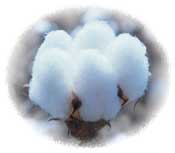No one knows exactly how old cotton is. Scientists searching
 caves in Mexico found bits of cotton bolls and pieces of cotton cloth that proved to be at least 7,000 years old. They also found that the cotton itself was much like that grown in America today.
caves in Mexico found bits of cotton bolls and pieces of cotton cloth that proved to be at least 7,000 years old. They also found that the cotton itself was much like that grown in America today.In the Indus River Valley in Pakistan, cotton was being grown, spun and woven into cloth 3,000 years BC. At about the same time, natives of Egypt’s Nile valley were making and wearing cotton clothing.
Arab merchants brought cotton cloth to Europe about 800 A.D. When Columbus discovered America in 1492, he found cotton growing in the Bahama Islands. By 1500, cotton was known generally throughout the world.
Cotton seed are believed to have been planted in Florida in 1556 and in Virginia in 1607. By 1616, colonists were growing cotton along the James River in Virginia.
Cotton was first spun by machinery in England in 1730. The industrial revolution in England and the invention of the cotton gin in the U.S. paved the way for the important place cotton holds in the world today.
 Eli Whitney, a native of Massachusetts, secured a patent on the cotton gin in 1793, though patent office records indicate that the first cotton gin may have been built by a machinist named Noah Homes two years before Whitney’s patent was filed. The gin, short for engine, could do the work 10 times faster than by hand.
Eli Whitney, a native of Massachusetts, secured a patent on the cotton gin in 1793, though patent office records indicate that the first cotton gin may have been built by a machinist named Noah Homes two years before Whitney’s patent was filed. The gin, short for engine, could do the work 10 times faster than by hand.The gin made it possible to supply large quantities of cotton fiber to the fast-growing textile industry. Within 10 years, the value of the U.S. cotton crop rose from $150,000 to more than $8 million

Model of Indian cotton gin
For the first two thousand years after people started to grow cotton in India, they just picked the seeds out by hand before they began to spin the cotton into thread. About 500 BC, cotton growers in India invented a machine with gears to turn rollers to get the seeds out of the cotton more quickly and easily.
Over time, people improved this machine, so that it could be run first by foot pedals and then by water power, using the current of a fast stream to turn the rollers.

Eli Whitney's cotton gin
When white people first began to grow cotton in North America in the 1600s AD, they brought over the cotton churka from India to help them get the seeds out. In the 1700s AD, people in the southern part of North America began to grow more and morecotton. Along the Atlantic coast, they could grow long-staple cotton, with long fibers that would work in the Indian cotton churka. But when people began to grow cotton further from the ocean, they found that the long-staple cotton didn't grow well there. They found a new short-staple kind of cotton, and grew that. But the old churkas wouldn't take the seeds out of this new short-staple cotton.
Cotton farmers forced African people to work as slaves and pick the cotton seeds out by hand. Mostly they made them do it in the evenings, after they'd already worked all day in the fields picking the cotton. This was too slow, and it made cotton very expensive - so expensive that nobody wanted to make clothes out of it.
This was a big problem, and a lot of people began to work on inventing a new kind of churka that would get the seeds out of short-staple cotton. Finally in 1793, just after the Revolutionary War, a young white man named Eli Whitney did invent a cotton gin that worked. It was a lot like the old churka, but it had steel teeth that caught the cotton fibers, and a system of pulleys to pull harder.
Cotton farmers all used the new cotton gin, and cotton clothing got so cheap that many people began to wear cotton instead of linen. Clothes got a lot cheaper, so that for the first time in history most people had more than one outfit to wear. The bad part was that in order to plant and pick so much cotton, the cotton farmers brought over thousands and thousands more African people to be their slavesand work in the cotton fields. Most of the African people who came to North America as slaves came because of the cotton gin.
No comments:
Post a Comment